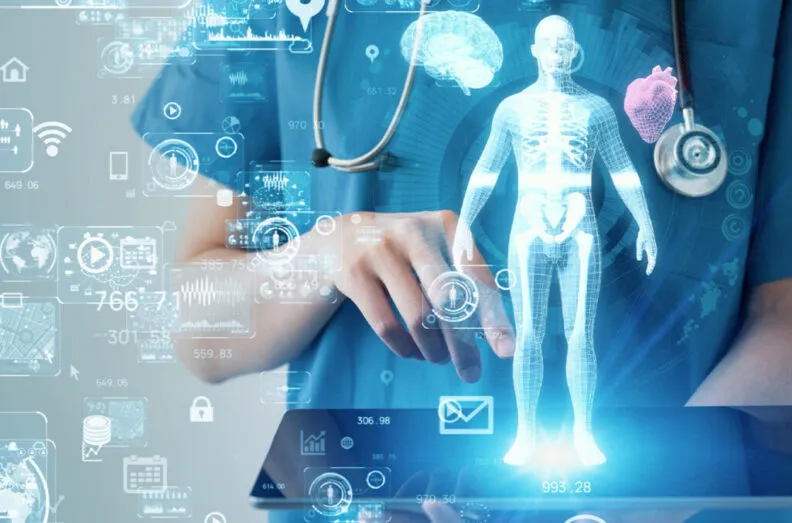In our rapidly advancing world, healthcare technology is reshaping how we perceive and engage with all aspects of life, especially healthcare. It wasn’t long ago that visiting the doctor involved lengthy waits and manual tests. Today, technology enables quicker, more accurate medical diagnoses, treatments, and patient care. This transformation is essential for healthcare professionals, tech enthusiasts, and patients, allowing them to engage effectively with modern healthcare solutions. In this post, we explore how technology is revolutionizing medical diagnosis, treatment, and patient care, improving accuracy, accessibility, and outcomes.

The Role of Technology in Healthcare
Healthcare technology is vast, covering innovations like AI-powered diagnosis, wearable health devices, and robotic surgery. These advancements streamline administrative tasks and equip healthcare professionals with tools to make faster, more informed decisions. By incorporating data analytics, artificial intelligence, and digital communication tools, healthcare providers can now deliver personalized care to patients, transforming the healthcare experience.
Technology is revolutionizing how medical professionals diagnose conditions, administer treatments, and monitor patients. Below, we explore the key areas where technology is reshaping healthcare.
Diagnosis and Detection
1. AI-Powered Diagnosis
Artificial intelligence (AI) is revolutionizing medical diagnosis. Advanced AI algorithms analyze medical images—X-rays, MRIs, and CT scans—to detect diseases with high precision. AI can spot patterns and abnormalities that may be missed by the human eye, significantly improving diagnostic accuracy and speed.
AI systems process large datasets quickly, enabling early disease detection, which is crucial for conditions like cancer. Early intervention often leads to better patient outcomes and higher survival rates. Additionally, natural language processing (NLP) algorithms can analyze patient records and research papers, offering insights and recommendations to healthcare professionals.
2. Wearable Health Devices
Wearable health devices, such as smartwatches and fitness trackers, have become essential tools for monitoring health. These devices track vital signs, physical activity, and sleep patterns, promoting preventive care and early detection of health anomalies.
Wearables provide valuable data to healthcare providers, allowing them to monitor chronic conditions like heart disease or diabetes and adjust treatment plans accordingly. For instance, some devices monitor heart rate variability, while others track glucose levels, offering real-time insights into a patient’s health status.
3. Telemedicine
Telemedicine has gained tremendous popularity in recent years in healthcare technology, especially in remote and underserved areas. Through video consultations, phone calls, and online messaging, patients can now access healthcare from the comfort of their homes.
Telemedicine eliminates travel and wait times, providing more flexible scheduling options. It’s effective for routine check-ups, follow-ups, and mental health support. By expanding access, telemedicine allows healthcare providers to reach a broader patient base while ensuring continuous care.
Treatment and Therapy
1. Robotic Surgery
Robotic surgery offers a groundbreaking advancement in treatment, enabling minimally invasive surgeries with enhanced precision. Controlled by skilled surgeons, robotic systems provide greater dexterity, reducing complications, recovery times, and post-operative pain.
Robotic surgery is now used for procedures such as prostatectomies, hysterectomies, and cardiac surgeries. Its precision makes it a preferred choice for patients and healthcare providers alike.
2. Personalized Medicine
Personalized medicine tailors treatments to individual patients based on their genetic profiles and characteristics. Advances in genetic testing and data analysis allow healthcare providers to develop targeted treatments, particularly for diseases like cancer.
By focusing on the unique genetic makeup of patients, personalized medicine improves treatment efficacy and minimizes side effects. It’s also being applied to conditions like cardiovascular diseases, diabetes, and autoimmune disorders, offering more effective and individualized care.
3. Virtual Reality (VR) Therapy
Virtual reality therapy is gaining traction in healthcare for pain management, mental health treatment, and rehabilitation. VR immerses patients in virtual environments, helping them manage pain or cope with anxiety and PTSD.
In rehabilitation, VR helps patients perform interactive exercises that promote recovery. Its ability to distract patients from pain and engage them in their treatment accelerates healing and reduces reliance on medication.
Patient Care and Experience
1. Electronic Health Records (EHRs)
Electronic health records (EHRs) digitize patient information, making it accessible to healthcare providers in real-time. This system enhances care coordination by enabling different medical professionals to access comprehensive patient data.
While EHRs offer clear benefits in patient care, they also raise concerns about data privacy. Protecting sensitive patient information through robust cybersecurity measures is essential to prevent unauthorized access.
2. Health Apps and Mobile Health
Health apps and mobile health solutions empower patients to take charge of their health by providing easy access to medical information, disease management tools, and medication reminders.
Apps enhance health literacy, helping individuals make informed decisions about their treatment and well-being. They also improve medication adherence by sending reminders, reducing the likelihood of missed doses and improving patient outcomes.
3. Remote Patient Monitoring (RPM)
Remote patient monitoring (RPM) uses connected devices to monitor patients’ health outside traditional settings. RPM is particularly valuable for managing chronic conditions like hypertension and diabetes, enabling early detection and intervention.
By engaging patients in their care and offering real-time monitoring, RPM improves health outcomes and reduces the need for emergency visits or hospitalizations.
Conclusion
Technology is driving a healthcare revolution, enhancing medical diagnosis, treatment, and patient care. From AI-powered diagnostics to telemedicine, robotic surgery, and personalized medicine, healthcare is becoming more accurate, accessible, and patient-centered.
As healthcare technology continues to evolve, it’s vital for healthcare professionals, tech enthusiasts, and patients to stay informed and embrace these innovations. By doing so, we can shape the future of healthcare, ensuring it becomes even more effective and inclusive.
Stay ahead in healthcare technology by subscribing to our blog for insights on the latest medical innovations! See more
